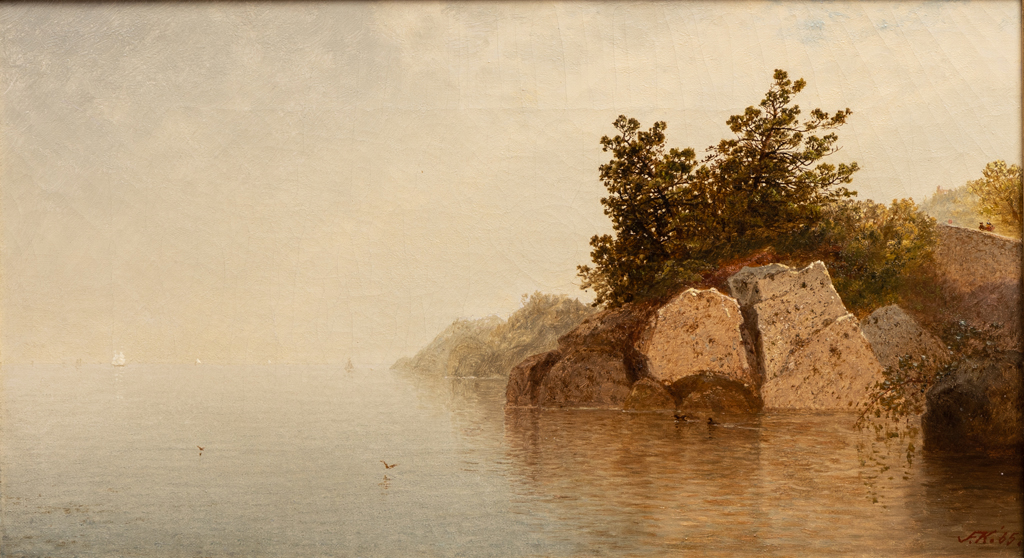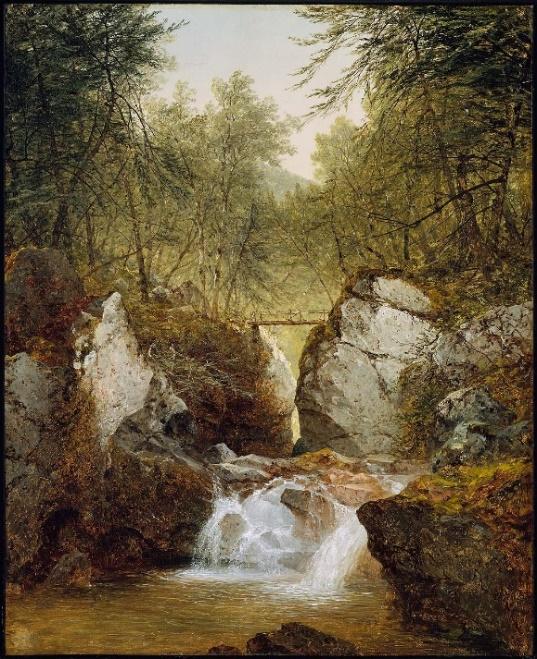
John Frederick Kensett (1816–72)
On the Beverly Coast, 1865
Oil on canvas
McMullen Museum of Art, Boston College, Carolyn A. and Peter S. Lynch Collection, 2021.21

Jeffery Howe
Professor Emeritus, Art History

John Frederick Kensett was a leading luminist artist, influenced by nineteenth-century Transcendentalism. His precise and accurate style was shaped by his early training as an engraver. This almost abstract vision of the rocky shore of Beverly, Massachusetts, depicts the Atlantic Ocean and horizon cloaked in a luminous mist. This evanescent realm of light and color is balanced by the harsh clarity of a rocky promontory with low trees at right. The stilled sea and split rocks have an elegiac undertone of calm after a storm, perhaps a metaphor for the end of the Civil War and desire for peace. The golden light of the distant sea also suggests a hope for freedom, transcending the burdens of earthly life.
Beverly was a popular summer resort at this time, called by some the “Riviera of Massachusetts.” Kensett often sketched at the nearby summer estate of Charles Greeley Loring, later trustee and director of the Museum of Fine Arts, Boston, and completed more than twenty paintings of the area. Loring’s estate (now demolished, near the site of Endicott College) faced a trio of beaches, one of which has an intriguing history. According to local historians, Mingo Beach (see photo) was named for Robin Mingo, an African American or Native American enslaved person owned by Thomas Woodberry. Legend has it that Mingo was promised his freedom if a rare low tide ever made it possible to walk to a distant off-shore rock, an event that unfortunately only occurred in the year he died (1748).
A further association of this locale with themes of freedom is found in the tradition that this beach was used as an escape route for those accused of witchcraft in nearby Salem; a local path is still called Witches Lane. Kensett chose scenes that were not only visually and geologically interesting, but had historic resonance. He painted Bash-Bish Falls in the Berkshires several times; the Falls were named for a Native American woman named Bash-Bish who had been condemned to death at that site (see image).


Bottom: Bash-Bish Falls, Massachusetts, 1855. Oil on canvas, Museum of Fine Arts, Boston.
John Sallis
Frederick J. Adelmann, SJ Professor, Philosophy

Early in his career Kensett traveled extensively in Europe, moving between London and Paris and settling for a period in Italy. When finally he decided to return to the United States, he expressed his desire in these words: he wanted “to get amid the scenery” of his own country, for, as he said, “it abounds with the picturesque, the grand, and the beautiful.” Upon his return, he set about painting scenes of the marshlands of coastal New England, as well as landscapes along the Hudson River, at Niagara Falls, in the Catskills and the Adirondacks. He established his reputation as the master of American luminism, a style that emphasizes smooth, seamless surfaces of light. Kensett alludes to a kind of luminism in a journal entry that reads: “the simplicity of strength and knowledge.” This expressionism is exemplified in a work such as On the Beverly Coast. In this painting much of the surface depicts water and sky; the work displays such simplicity that only the slightest shading betrays the division between sea and sky. A sense of strength is conveyed by the rocks, which are securely anchored. One can readily imagine that arboreal figure that backs them is a tree of knowledge, toward which the two human figures at the extreme right appear to be walking across a stony ledge, its color mirroring that of the large stone in the foreground of the painting.
